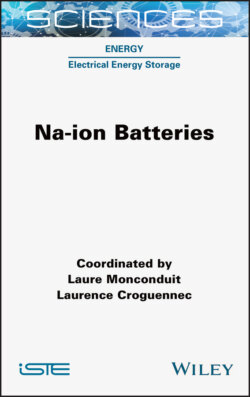Читать книгу Na-ion Batteries - Laure Monconduit - Страница 27
1.3.1.4. O3-NaFeO2
ОглавлениеAnother elementally attractive material in terms of abundant resources is O3-NaFeO2. Although O3-NaFeO2 is well known as a typical structural type of α-NaFeO2, the electrochemical properties were first reported by Takeda et al. in 1994 (Takeda et al.1994) and O3-NaFeO2 delivers a discharge capacity of ca. 120 mAh g−1 based on Fe3+/4+ redox in the Li cell. The electrochemical Fe3+/4+ redox activity was a surprising fact because O3-LiFeO2 delivers a reversible capacity of <10 mAh g−1 and is electrochemically inactive unlike O3-NaFeO2. Moreover, O3-LiFeO2 cannot be directly synthesized by a solid-state reaction and is prepared by Li+/Na+ ion-exchange from O3-NaFeO2 (Ado et al. 1997) due to the relatively large ionic radius of Fe3+ as shown in Figure 1.3. As is the case in the Li cell, O3-NaFeO2 is electrochemically active in a Na cell and delivers a reversible capacity of ca. 80 mAh g−1 based on Fe3+/4+ redox with a flat potential plateau at ca. 3.3 V versus Na+/Na in the voltage range of 2.5–3.4 V (Figure 1.8) (Takahashi et al. 2004; Okada et al. 2006; Yabuuchi et al. 2012b; Zhao et al. 2013; Li et al. 2018). Fe3+/4+ redox was confirmed with 57Fe Mössbauer spectroscopy (Takeda et al. 1994; Zhao et al. 2013; Lee et al. 2015) and oxidation of oxide ions was recently revealed with soft XAS at O K-edge (Li et al. 2018). The mean working voltage of 3.3 V is the highest among single 3d transition metal O3 and O’3 systems. When Na+ ions are extracted by >0.5 mole from NaxFeO2 upon a charging process, the discharge capacity significantly deteriorates due to an irreversible structural change accompanied by Fe migration into the interslab space (Yabuuchi et al. 2012b) as seen in NaTiO2, NaVO2 and NaCrO2. Detailed phase transitions during charge/discharge were studied with ex situ 57Fe Mössbauer spectroscopy and operando synchrotron XRD by Lee et al. and the results revealed non-equilibrium phase-transition behavior among original O3, secondary O3 and O’3 phases in which iron ions simultaneously migrate into interslab space even in x ≤ 0.5 in NaxFeO2 (Lee et al. 2015). Furthermore, reduction of Fe4+ accompanied by electrolyte decomposition was also observed during storage for 2 days after charging to 3.6 V. Suppression of the electrolyte decomposition and of the migration of iron ions is required to utilize Fe3+/4+ redox in layered oxides for Na-ion batteries.
